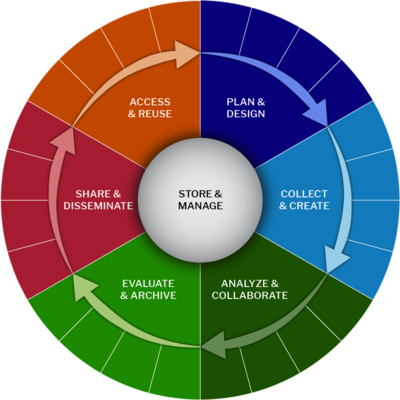Research
Learning Objectives
- Define the research lifecycle
- Identify where to find research support from University Libraries
- Understand this chapter
New Faculty and Graduate Student Research
As you move through your career at Texas State University, you will be charged with contributing to the research literature in your field. The Research chapters of this resource will help guide you through the ways in which the library can help you at many of the stages of the research lifecycle.
What is the Research Lifecycle?

The research lifecycle refers to the stages that your research project moves through as you conduct it.
Plan & Design
You begin your research project by creating a plan for the work you will be doing, including a data management plan if you are working with data. You should also begin to think about where you’d like to publish.
Collect & Create
At this phase, you will be starting to collect your data and create a running bibliography of the sources you will be citing.
Analyze & Collaborate
Once you have collected the majority of your data and resources, you will begin the process of analyzing the data and collaborating with your peers and/or advisors on the progress of your project.
Evaluate & Archive
It is important to include a plan for proper storage of your data or resources. This is a good time to save your cleaned and analyzed data sets, as well as evaluate your progress on the project.
Share & Disseminate
Now that you have done bulk of your work, you should start applying for publication, assigning permanent identifiers to your work, submit your preprint to the archive, and add your work to your researcher profiles.
Access & Reuse
It is important to provide access to your work. There are a number of places that Texas State University provides for you to store your work open access so that it can be viewed and reused.
Support for Researchers
At Texas State University Libraries, we recognize that each part of the research process is unique and requires special attention. That is why we have organized this section into six chapters that highlight the stages individually. We are able to provide you with a robust set of resources and guidance at every stage of your project. Furthermore, we know that a research project doesn’t end at publication, but requires attention long after you’ve received that acceptance letter.
Our Digital Scholarship & Research team includes experts who can help you in the following areas:
- Data Curation and Management
- Digital Publishing
- Primary Sources
- Copyright & Open Licensing
Please visit our Research and Publishing Page for more information.
Understanding this Chapter
There are six different sections in this chapter that aim to cover many parts of the research lifecycle. During this time, we would like to highlight three important processes that will help your project run smoothly and reach a wider audience. Research Data Management, which covers the entire lifecycle of your data. Preservation and dissemination, which will highlight our institutional repositories, as well as key concepts that are important to understand for the long-term preservation and reach of your projects. And, Discovery and Impact, which will guide you through creating your researcher profile, marketing, and promoting your work.
Please move through this chapter linearly or as you feel the need, and don’t forget to bookmark pages as you go!
Diggin Deeper
- Continue to Planning Your Research to get started!
- Visit our Research and Publishing Page webpage.
The research lifecycle refers to the stages that your research project moves through as you conduct it.

